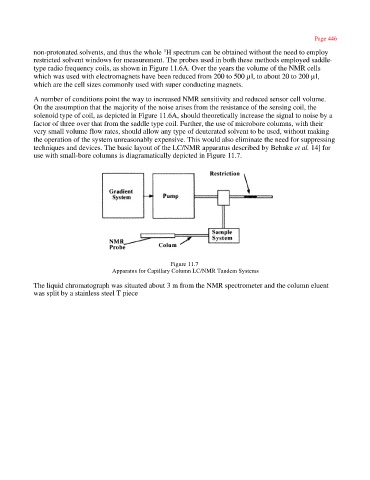Page 462 - Tandem Techniques
P. 462
Page 446
non-protonated solvents, and thus the whole H spectrum can be obtained without the need to employ
1
restricted solvent windows for measurement. The probes used in both these methods employed saddle-
type radio frequency coils, as shown in Figure 11.6A. Over the years the volume of the NMR cells
which was used with electromagnets have been reduced from 200 to 500 µl, to about 20 to 200 µl,
which are the cell sizes commonly used with super conducting magnets.
A number of conditions point the way to increased NMR sensitivity and reduced sensor cell volume.
On the assumption that the majority of the noise arises from the resistance of the sensing coil, the
solenoid type of coil, as depicted in Figure 11.6A, should theoretically increase the signal to noise by a
factor of three over that from the saddle type coil. Further, the use of microbore columns, with their
very small volume flow rates, should allow any type of deuterated solvent to be used, without making
the operation of the system unreasonably expensive. This would also eliminate the need for suppressing
techniques and devices. The basic layout of the LC/NMR apparatus described by Behnke et al. 14] for
use with small-bore columns is diagramatically depicted in Figure 11.7.
Figure 11.7
Apparatus for Capillary Column LC/NMR Tandem Systems
The liquid chromatograph was situated about 3 m from the NMR spectrometer and the column eluent
was split by a stainless steel T piece

